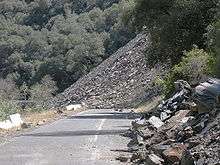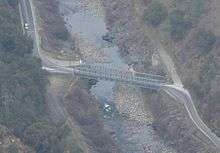Ferguson landslide
The Ferguson landslide, also commonly called the Ferguson Slide, is an active landslide in the Merced River canyon in the U.S. state of California which in 2006 blocked a primary access road to Yosemite National Park. The slide still blocked the original road as of early 2020, although temporary bridges allow one-way traffic around the slide and into the park. The slide is a natural phenomenon, and resulted from the erosion dynamics of the river valley.[1]

The slide began on April 29, 2006, and initially the highway remained open, with active monitoring and occasional temporary closures. By May 28, the road was closed permanently, stopping access to the park from Mariposa and severely impacting the local economy. Many park employees reside in Mariposa, and for several months a two-hour trip (one way) was required to get to work in the park. Revenue via the hospitality market dropped extensively, which included wages, profits to small business owners, and county government income from occupancy taxes. A State of Emergency was declared in June 2006 for Mariposa County.[1]

Initially two temporary bridges were built in August 2006. While this detour alleviated a significant portion of the economic impact to the area, vehicles over 28 feet could not use it. In June 2008, new temporary bridges which could accommodate longer vehicles were constructed. The detour via the bridges is one-way, controlled by traffic lights. At the height of the tourist season, this has sometimes resulted in significant delays.[1]
The temporary bridges access a road grade, on the north side of the river, which is a vestige of the Yosemite Valley Railroad.
Repair of the highway was on permanent hold due to the encroachment of an endangered species into the slide area. In 2012, Assemblymember Kristin Olsen authored legislation that would allow the California Department of Fish and Game to do an initial take of the Limestone Salamander and place it in an Ecological Reserve. The legislation paved the way to restoring this important access route to Yosemite. Known officially as Assembly Bill No. 1973, it passed both houses of the California State Legislature and was signed into law by Governor Jerry Brown on July 13, 2012.[1][2] After considering the option of a tunnel, CalTrans settled on a rock shed design in 2014.[3]
Ferguson Rock Shed
The Ferguson Project located in the Merced River Canyon on Highway 140 into Yosemite National Park will result in the longest structure of its kind in State of California and only the second to be completed in the State.
The Ferguson Project Team was formed in 2008 to work toward developing the Ferguson Project that will restore full access through the Merced River Canyon in Mariposa County, California. After completion of all necessary environmental studies, and receiving feedback from local government agencies, the U.S. Forest Service, the U.S. Department of Interior, the public and other stakeholders, the Ferguson Project team completed the environmental document and project report in early 2014. The team recommended that the Rock Shed Alternative move forward in final design. The project construction will be in two distinct construction projects.
Phase 1: Will remove the existing talus material and install cable drapery to minimize additional rock fall. Work will begin in spring 2015.
Phase 2: Will construct a 750-foot rockshed structure on the same alignment.
Throughout the duration of the both phase 1 and phase 2 Highway 140 is expected to stay open – there are no closures scheduled. The project is expected to be completed by summer 2020.[1]
References
- DOT 2014.
- "Bill Text - AB-1973 Protected species: take: Ferguson Slide Permanent Restoration Project". Retrieved June 10, 2015.
- Skindrud 2014.
- Attributions
- "State Route 140 Ferguson Slide Permanent Restoration Project". California Department of Transportation. Retrieved January 11, 2014.
- Skindrud, Erik (August 29, 2013). "Permanent fix eyed for Highway 140". Mariposa Gazette. Retrieved January 11, 2014.CS1 maint: ref=harv (link)
- Skindrud, Erik (March 6, 2014). "Rockshed gets thumbs up from state planners". Mariposa Gazette. Retrieved May 28, 2014.CS1 maint: ref=harv (link)